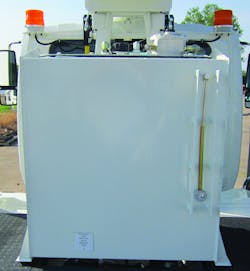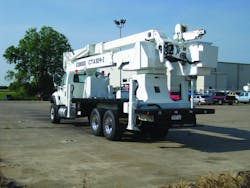Desiccant filter breathers are being used more and more to trap moisture before it gets into a hydraulic reservoir. Although effective, they do not necessarily offer a permanent solution. That’s because the desiccant eventually becomes spent, and unless the desiccant or the entire unit is replaced, moisture will again be drawn into the reservoir.
But water getting into the hydraulic fluid is only one problem. The other is when water causes the interior surfaces of the reservoir to rust. Rust particles will find their way into the hydraulic fluid to wreak havoc on pumps, valves, and other key components unless they are trapped by filters. Pump manufacturers generally recommend not using a filter on pump suction lines, so a coarse screen may be the only protection for the pump.
Stainless steel reservoirs could be used, but usually are too expensive to be practical. The IFH Group, Rock Falls, Ill., offers a more cost-effective solution: aluminized steel. Aluminized steel is sheet steel hot dip coated on both sides with an aluminum-silicon alloy. It solves the contamination problems inherent to uncoated steels by combining the corrosion resistance of aluminum with the structural strength (and lower cost) of steel.
Ryan McCarty, of the IFH Group, explained that aluminized steel reservoirs are compatible with virtually all petroleum-based and synthetic fluids while providing protection from atmospheric corrosion. Each reservoir is customized to meet application requirements and is available in capacities from 1 to more than 300 gal.
McCarty continued, “Custom made hydraulic reservoirs have an advantage over off-the-shelf units because they are designed to fit the exact space and technical requirements necessary for the optimal performance of the end product. When you’re 100 ft in the air working on 500 kV transmission lines from a telescopic aerial work platform, nothing less than optimal performance will do.”
The IFH Group manufactures reservoirs and tanks for fuel and other fluids. Materials range from mild steel, stainless steel, and aluminum, to aluminized steel. “We use whichever material is best suited to the application,” added McCarty, “whether it’s a forklift, combine, boom crane or a specialized military vehicle.”
All reservoirs and tanks are delivered clean and pressure-tested. Once the tank or reservoir is finished, the company can provide powder coating, CARC (chemical agent resistant coating) and sub-assembly, including the addition of component parts such as fill caps, filters, sight gauges, sending units, hoses and more. “We offer everything from a simple two-part tank strap to hydraulic reservoir tanks with more than 60 different parts,” noted McCarty. “The more we provide, the fewer vendors the customer needs to use.”
For more information, visit www.ifhgroup.com or email [email protected].



